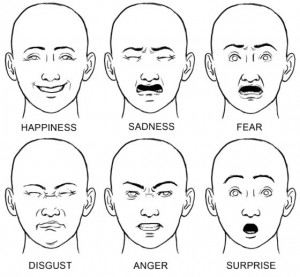How To Describe A Sad Face In Writing
Describing characters imaginatively is an essential skill when writing fiction. It helps readers to invest in your characters' storylines and experiences if they feel real. Read on for five tips for describing characters' faces:
Describing characters: 5 tips for drawing faces with words
Ready to write great characters? Here's how to make sure each character feels real and distinctive:
Tip 1: Use gestures more than easy adjectives
Beginning writers will often use adjectives for specific emotions to describe faces: 'Her eyes were angry' or 'his mouth was mean'. Because adjectives that use abstract words for specific emotions don't show the reader the character's face, they tell rather than show emotion. Ask yourself: What makes the character's eyes seem angry? Does she glare, unblinking? Are her brows knitted together? Our faces are mobile and you can use this movement to convey a character's mental or emotional state lucidly.
Instead of 'Her face held an amused expression' think of what makes a face have this appearance and try to describe the visual elements of this amusement. You could describe a slight smile that seems to teeter on the edge of a loud cackle or a single-sided smile, a curled lip that could indicate sardonic, begrudging amusement.
The eyes are elements of character description that budding writers often rely on too heavily:
Tip 2: Avoid descriptions of eyes that are generic and say nothing about your character

Description of eye colour is often used in place of eye descriptions that give characters more personality or individuality. 'He was a blue-eyed surfer' doesn't tell the reader much about the character other than the surface physical appearance. Instead, focus on how the eyes can say more about a person: their emotions, passions or attitudes. An example: 'His blue eyes were often red underneath, whether from the constant irritation of salt water or the countless sleepless nights he spent at the beachside bar, she didn't know.'
Some common clichés to avoid in describing eyes:
- Changes of colour designating changing emotions: In real life people's eyes don't change colour like mood rings. 'Her usually blue eyes were now a steely grey' reads as strange because it doesn't ring true
- Overworn similes and metaphors: Similes such as 'her eyes grew wide as plates' or 'his eyes bulged in anger' are overused and (especially in the case of the former) exaggerations. Sometimes, instead of making faces your first stop for describing emotions, it's wiser to involve the whole body in descriptions. Bring everything together – posture, voice and movement – so that your characters don't float through your novel as disembodied, over-animated faces.
Even though facial movement can be effective for describing your characters' inner thoughts and feelings and outward expressions of these, facial tics should also be handled with care:

Write vivid descriptions
Get a practical workbook with description exercises, examples plus videos to level up your characters.
GET GUIDE
Tip 3: Aim for natural use of facial tics and expressions
Overuse of facial tics is a common pitfall. Often (in fantasy novels especially) writers use the stock character of a stern female character who raises one eyebrow archly, continuously. Too many characters raise eyebrows to show disdain too many times in too many books. Think about people you know personally – how often do they perform the facial gestures you describe? Raising the entire forehead is far more common an expression of questioning surprise, for example, than raising just one eyebrow.
Other facial tic clichés:
- Eyes scrunched tight in anticipation of something bad: Again, body language is often stronger than facial description for these scenarios. For example, if a character is expecting a beating, their body is where they will imagine approaching pain and thus it is where this expectation will register first
- Wrinkling your nose:Ask yourself how often people do actually wrinkle their noses. Besides the nose being connected to surrounding facial tissue, someone is probably more likely to hold their nose closed when noticing a bad smell, or they might breath through their mouth until the odour has passed
There are other facial tics to avoid. A good exercise to become skilled at describing faces is to watch a TV series or movie featuring good actors and observe and note how each type of emotion or scenario changes a character's face. Observe colour, movement and anything that is particularly striking or individualistic about a character's expression. One person's lip might protrude a little when holding back tears, while another might remain resolutely tight-lipped. These small details enrich facial description.
Tip 4: Be inventive in the similes you use to describe characters
Instead of relying on clichés to describe characters' faces, think up similes that convey something essential about your characters and mark them as unique. In Charles Dickens'Great Expectations, the clerk Wemmick is described as having a mouth like a postbox, a 'post-office mouth' that is used for sorting and relaying information. The postal metaphor for Wemmick conveys a lot about the character: The mechanical, practical nature with which he goes about his professional life as well as how his working life asks so much commitment of him, even down to affecting his physical appearance.
Be an inventor like Dickens in describing characters' faces. Think about not just the appearance of their facial elements and structure but how they use them and what causes them to use their features in this identifying way. You can also find more articles on describing character at our character writing hub.
To make your characters' faces vivid and lifelike, also think about their attitudes to their faces, the features they like or dislike or the care they take (or don't take) over how their faces appear:
Tip 5: Combine facial description with behavioural description

One of the useful elements of describing characters and using their faces in description is that you can show cause and effect in a character's life. A character who is a night owl or is up awake fretting for a long period of time will come to have dark circles under their eyes. Don't just say that a character has dark circles: Instead show how the character's behaviour starts to affect the way their face appears.
To illustrate: You could say 'she had dark circles beneath her eyes', which suggests tiredness and lack of sleep, or you could say 'the circles beneath her eyes darkened with each night she stayed up to fill out job applications'. In the latter, direct behavioral cause and physical result are clear.
Another advantage of the latter type of facial description is that it shows readers that characters' faces, like the rest of them, do not need to be static and mask-like but can and should alter with time according to their thoughts, feelings and behaviours.
Want to write better characters? Start creating vivid characters and get feedback on their portrayal from other members of the Now Novel community now.
Image from here, here and here.
How To Describe A Sad Face In Writing
Source: https://www.nownovel.com/blog/talking-character-face/
Posted by: duplantislifehout.blogspot.com

0 Response to "How To Describe A Sad Face In Writing"
Post a Comment